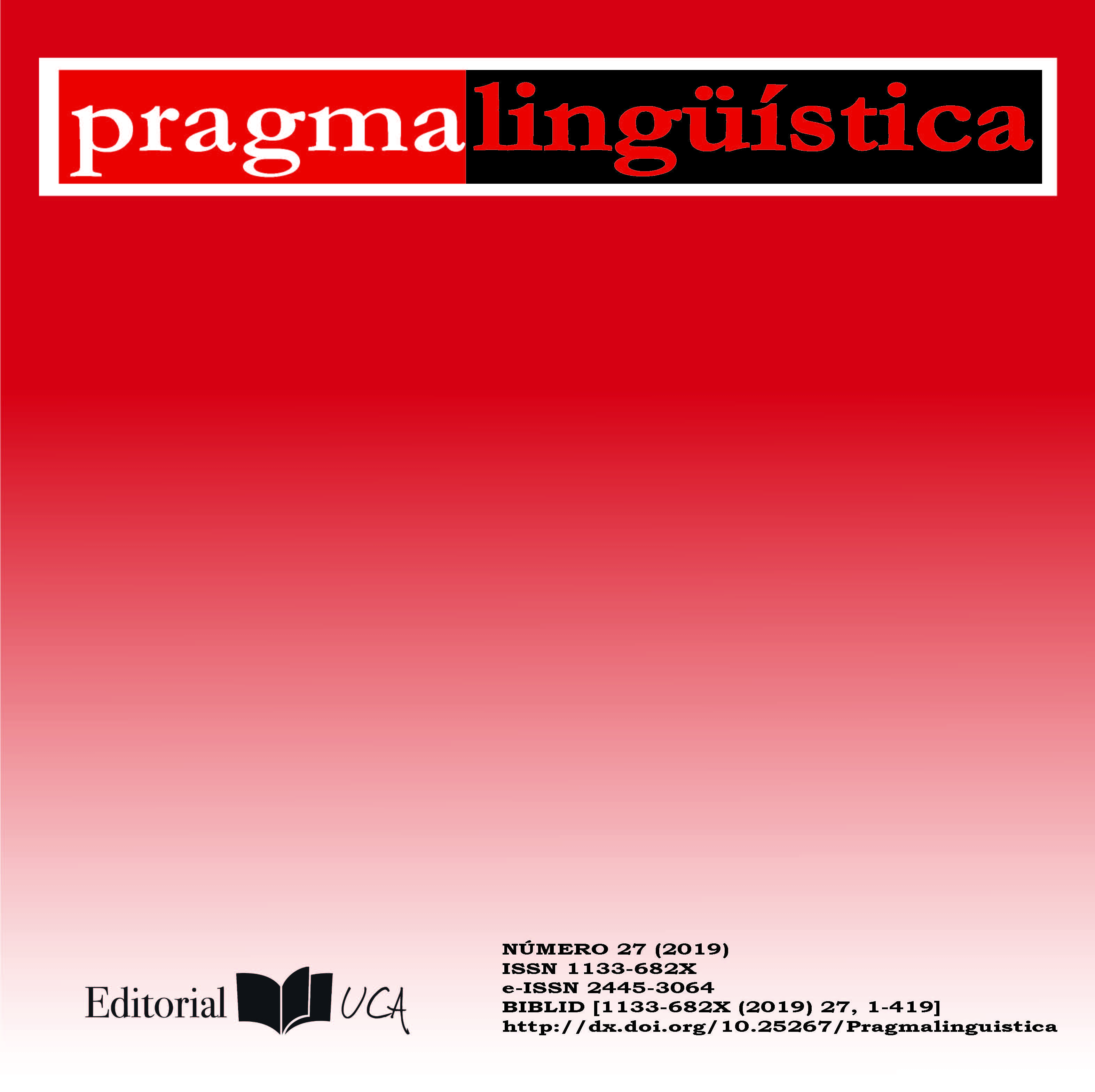Evidential meanings of o eso dicen
Abstract
In this paper, we analyze the evidential values transmitted by the Spanish construction o eso dicen (‘or so they say’). We examine the different discursive and syntactic patterns in which this construction appears, as well as its use as a mark of indirect evidentiality. The analysis is carried out in the Corpus de Español (Web/Dialects section) and focuses on the European variety of Spanish. We conclude that o eso dicen transmits different values of evidentiality, such as report, rumor and folklore and this depends on factors related to the fixation of the construction, the type of the source of information to which it refers and the nature of its scope. Also, we confirm that that this construction often shows the speaker’s distancing or disagreement with the reported information, although this function is not as prominent when it is used as a folklore marker.
Keywords
Downloads
Supporting Agencies
How to Cite
License

This work is licensed under a Creative Commons Attribution-NonCommercial-NoDerivatives 4.0 International License.
References
AIKHENVALD, A.Y. (2004): Evidentiality. Oxford: Oxford University Press.
AIKHENVALD, A.Y. (2007): “Information source and evidentiality: what can we conclude?”, Rivista Di Linguistica, 19(1), pp. 209-227.
AIKHENVALD, A.Y. (ed.) (2018): The Oxford Handbook of Evidentiality, Oxford: Oxford University Press.
ALBELDA, M. (2015): “Introduction: Evidentiality in non-evidential languages: Are there evidentials in Spanish?”, Journal of Pragmatics, 85, pp. 135-137.
ANDERBOIS, S. (2014): “On the exceptional status of reportative evidentials”, Proceedings of SALT, 24, pp. 234-254.
BERMÚDEZ, F. (2005): Evidencialidad. La codificación lingüística del punto de vista, tesis doctoral, Stockholm: Stockholms Universitet.
CHAFE, Wallace L. (1986): “Evidentiality in English Conversation and Academic Writing”, Chafe, W. L. y Nichols, J. (eds.): Evidentiality: The Linguistic Coding of Epistemology, Norwood, New Jersey: Ablex Publishing Corporation, pp. 261-272.
CORNILLIE, B. (2016): “Las lecturas evidenciales de los verbos (semi)auxiliares en español”, González Ruiz, R. et al. (eds.): La evidencialidad en español: teoría y descripción, Frankfurt am Main: Iberoamericana Vervuert, pp. 227-250.
DE LA MORA, J. y MALDONADO, R. (2015): “Dizque: Epistemics blurring evidentials in Mexican Spanish”, Journal of Pragmatics, 85, pp. 168-180.
ESCANDELL VIDAL, M.V. (2010): “Futuro y evidencialidad”, Anuario de Lingüística Hispánica, 25, pp. 9-34.
FALLER, M. (2002): Semantics and Pragmatics of evidentials in Cuzco Quechua, tesis doctoral.
GARCÍA NEGRONI, M. M. (2016): “Polifonía, evidencialidad citativa y tiempos verbales. Acerca de los usos citativos del futuro morfológico y del futuro perifrástico”, González Ruiz, R. et al. (eds.): La evidencialidad en español: teoría y descripción, Frankfurt am Main: Iberoamericana Vervuert, pp. 279-301.
GONZÁLEZ VÁZQUEZ, M. (2016): “La naturaleza y función de la evidencialidad en español”, González Ruiz, R. et al. (eds.): La evidencialidad en español: teoría y descripción, Frankfurt am Main: Iberoamericana Vervuert, pp. 49-74.
GRAS, P. (2016): “Entre la codificación y la inferencia. Los valores citativos de que inicial átono en español”, González Ruiz, R. et al. (eds.): La evidencialidad en español: teoría y descripción, Frankfurt am Main: Iberoamericana Vervuert, pp. 201-223.
HASSLER, G. (2010): “Epistemic modality and evidentiality and their determination on a deictic basis: the case of Romance languages”, Diewald, G. y Smirnova, E. (eds.): Linguistic Realization of Evidentiality in European Languages, Berlín-Nueva York: de Gruyter Mouton, pp. 223-248.
HARRIS, J.A. y POTTS, C. (2009): “Perspective-shifting with appositives and expressives” Linguistics & Philosophy, 32(6), pp. 523-552.
LAMPERT G. y LAMPERT, M. (2010): “Where does evidentiality reside? Notes on (alleged) limiting cases: seem and be like”, STUF - Language Typology and Universals Sprachtypologie und Universalienforschung, 63 (4), pp. 308-321.
LAZARD, G. (2001): “On the grammaticalization of evidentiality”, Journal of Pragmatics, 33, pp. 359-367.
MIGLIO, V.G. (2010): “Online databases and language change: The Case of Spanish dizque”, Gries, S.Th. et al. (eds.): Corpus Linguistics Applications: Current Studies, New Directions (Language and Computer Series), Amsterdam: Rodopi pp. 7-28.
PLUNGIAN, V. A. (2001): “The place of evidentiality within the universal grammatical space”, Journal of Pragmatics, 33, pp. 349-357.
PLUNGIAN, V. (2010): “Types of verbal evidentiality marking: an overview”, Diewald, G. y Smirnova, E. (eds.): Linguistic Ralization of Evidentiality in European Languages, Berlín-Nueva York: de Gruyter Mouton, pp. 15-58.
REYES, G. (1994): Los procedimientos de cita: citas encubiertas y ecos. Madrid: Arco/Libros.
RODRÍGUEZ ROSIQUE, S. (2015): “Distance, evidentiality and counter-argumentation: Concessive future in Spanish”, Journal of Pragmatics 85, pp. 181-199.
WILLET, T. (1988): “A Cross-Linguistic Survey of the Grammaticalization of Evidentiality”, Studies in Language, 12(1), pp. 51–97.







